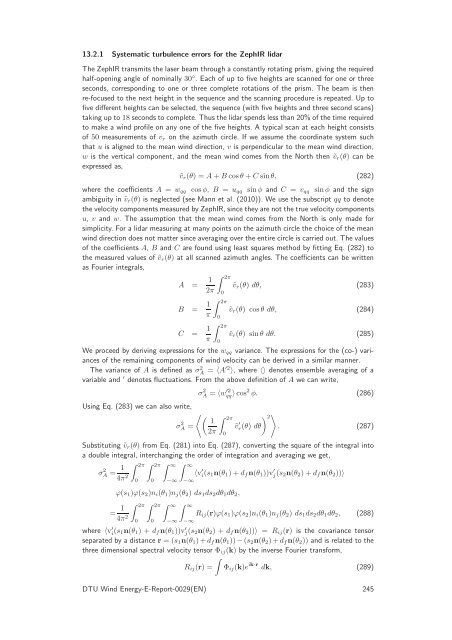Publishers version - DTU Orbit
Publishers version - DTU Orbit
Publishers version - DTU Orbit
You also want an ePaper? Increase the reach of your titles
YUMPU automatically turns print PDFs into web optimized ePapers that Google loves.
13.2.1 Systematic turbulence errors for the ZephIR lidar<br />
The ZephIR transmits the laser beam through a constantly rotating prism, giving the required<br />
half-opening angle of nominally 30 ◦ . Each of up to five heights are scanned for one or three<br />
seconds, corresponding to one or three complete rotations of the prism. The beam is then<br />
re-focused to the next height in the sequence and the scanning procedure is repeated. Up to<br />
five different heights can be selected, the sequence (with five heights and three second scans)<br />
taking up to 18 secondsto complete. Thus the lidar spends less than 20% of the time required<br />
to make a wind profile on any one of the five heights. A typical scan at each height consists<br />
of 50 measurements of vr on the azimuth circle. If we assume the coordinate system such<br />
that u is aligned to the mean wind direction, v is perpendicular to the mean wind direction,<br />
w is the vertical component, and the mean wind comes from the North then ˜vr(θ) can be<br />
expressed as,<br />
˜vr(θ) = A+Bcosθ+Csinθ, (282)<br />
where the coefficients A = wqq cosφ, B = uqq sinφ and C = vqq sinφ and the sign<br />
ambiguity in ˜vr(θ) is neglected (see Mann et al. (2010)). We use the subscript qq to denote<br />
the velocitycomponentsmeasured byZephIR,since theyare not the true velocitycomponents<br />
u, v and w. The assumption that the mean wind comes from the North is only made for<br />
simplicity. For a lidar measuring at many points on the azimuth circle the choice of the mean<br />
wind direction does not matter since averaging over the entire circle is carried out. The values<br />
of the coefficients A, B and C are found using least squares method by fitting Eq. (282) to<br />
the measured values of ˜vr(θ) at all scanned azimuth angles. The coefficients can be written<br />
as Fourier integrals,<br />
2π<br />
A = 1<br />
˜vr(θ) dθ, (283)<br />
2π 0<br />
B = 1<br />
2π<br />
˜vr(θ) cosθ dθ, (284)<br />
π 0<br />
C = 1<br />
2π<br />
˜vr(θ) sinθ dθ. (285)<br />
π 0<br />
We proceed by deriving expressions for the wqq variance. The expressions for the (co-) variances<br />
of the remaining components of wind velocity can be derived in a similar manner.<br />
The variance of A is defined as σ2 A = 〈A′2 〉, where 〈〉 denotes ensemble averaging of a<br />
variable and ′ denotes fluctuations. From the above definition of A we can write,<br />
Using Eq. (283) we can also write,<br />
σ 2 A =<br />
σ 2 A<br />
= 〈w′2<br />
qq 〉cos2 φ. (286)<br />
2π<br />
1<br />
˜v<br />
2π 0<br />
′ 2<br />
r (θ) dθ<br />
<br />
. (287)<br />
Substituting ˜vr(θ) from Eq. (281) into Eq. (287), converting the square of the integral into<br />
a double integral, interchanging the order of integration and averaging we get,<br />
σ 2 A = 1<br />
4π 2<br />
2π<br />
2π<br />
∞ ∞<br />
0<br />
0<br />
−∞<br />
−∞<br />
ϕ(s1)ϕ(s2)ni(θ1)nj(θ2) ds1ds2dθ1dθ2,<br />
= 1<br />
4π 2<br />
2π<br />
2π<br />
∞ ∞<br />
0<br />
0<br />
−∞<br />
−∞<br />
〈v ′ i(s1n(θ1)+dfn(θ1))v ′ j(s2n(θ2)+dfn(θ2))〉<br />
Rij(r)ϕ(s1)ϕ(s2)ni(θ1)nj(θ2) ds1ds2dθ1dθ2, (288)<br />
where 〈v ′ i (s1n(θ1) + dfn(θ1))v ′ j (s2n(θ2) + dfn(θ2))〉 = Rij(r) is the covariance tensor<br />
separated by a distance r = (s1n(θ1)+dfn(θ1))−(s2n(θ2)+dfn(θ2)) and is related to the<br />
three dimensional spectral velocity tensor Φij(k) by the inverse Fourier transform,<br />
<br />
Rij(r) = Φij(k)e ik·r dk, (289)<br />
<strong>DTU</strong> Wind Energy-E-Report-0029(EN) 245

















